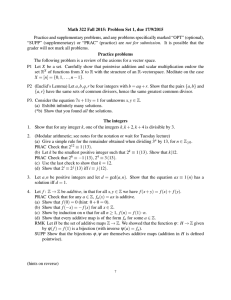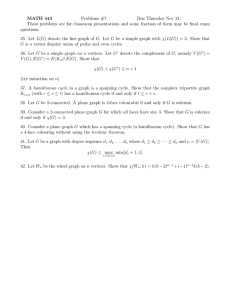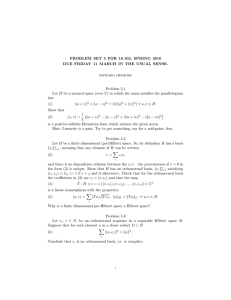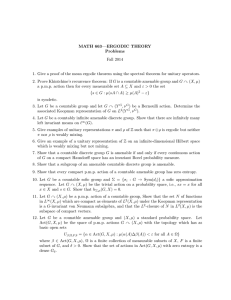Math 422/501: Problem set 5 (due 14/9/09) Ideals in Rings
advertisement
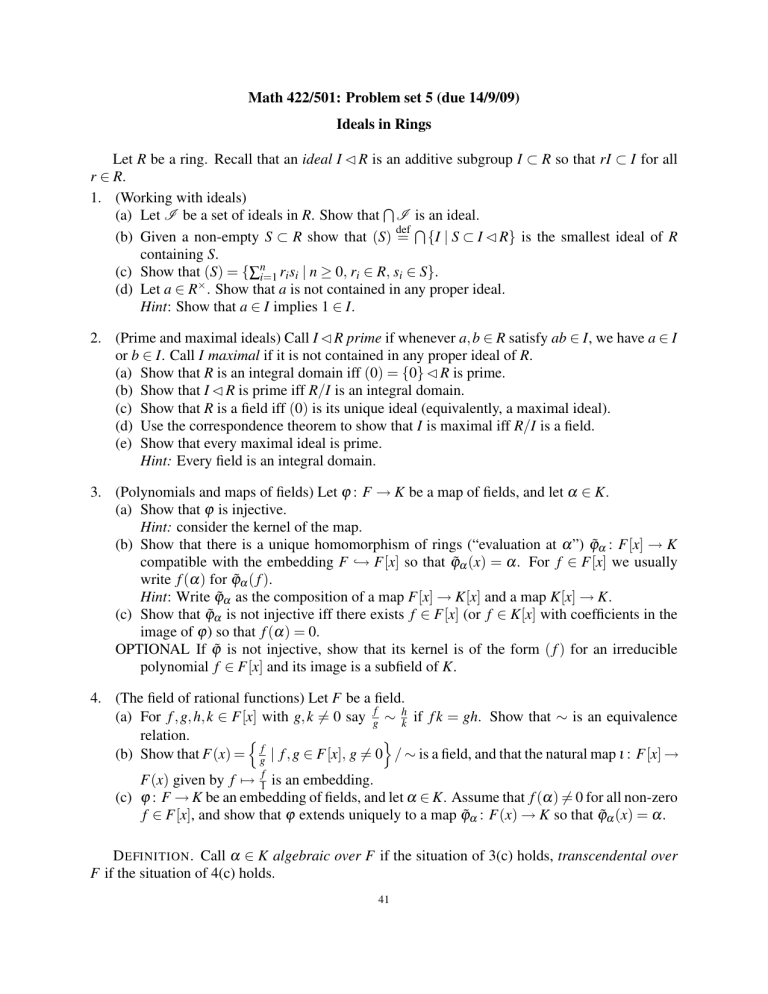
Math 422/501: Problem set 5 (due 14/9/09)
Ideals in Rings
Let R be a ring. Recall that an ideal I C R is an additive subgroup I ⊂ R so that rI ⊂ I for all
r ∈ R.
1. (Working with ideals)
T
(a) Let I be a set of ideals in R. Show that I is an ideal.
def T
(b) Given a non-empty S ⊂ R show that (S) = {I | S ⊂ I C R} is the smallest ideal of R
containing S.
(c) Show that (S) = {∑ni=1 ri si | n ≥ 0, ri ∈ R, si ∈ S}.
(d) Let a ∈ R× . Show that a is not contained in any proper ideal.
Hint: Show that a ∈ I implies 1 ∈ I.
2. (Prime and maximal ideals) Call I C R prime if whenever a, b ∈ R satisfy ab ∈ I, we have a ∈ I
or b ∈ I. Call I maximal if it is not contained in any proper ideal of R.
(a) Show that R is an integral domain iff (0) = {0} C R is prime.
(b) Show that I C R is prime iff R/I is an integral domain.
(c) Show that R is a field iff (0) is its unique ideal (equivalently, a maximal ideal).
(d) Use the correspondence theorem to show that I is maximal iff R/I is a field.
(e) Show that every maximal ideal is prime.
Hint: Every field is an integral domain.
3. (Polynomials and maps of fields) Let ϕ : F → K be a map of fields, and let α ∈ K.
(a) Show that ϕ is injective.
Hint: consider the kernel of the map.
(b) Show that there is a unique homomorphism of rings (“evaluation at α”) ϕ̃α : F[x] → K
compatible with the embedding F ,→ F[x] so that ϕ̃α (x) = α. For f ∈ F[x] we usually
write f (α) for ϕ̃α ( f ).
Hint: Write ϕ̃α as the composition of a map F[x] → K[x] and a map K[x] → K.
(c) Show that ϕ̃α is not injective iff there exists f ∈ F[x] (or f ∈ K[x] with coefficients in the
image of ϕ) so that f (α) = 0.
OPTIONAL If ϕ̃ is not injective, show that its kernel is of the form ( f ) for an irreducible
polynomial f ∈ F[x] and its image is a subfield of K.
4. (The field of rational functions) Let F be a field.
(a) For f , g, h, k ∈ F[x] with g, k 6= 0 say gf ∼ hk if f k = gh. Show that ∼ is an equivalence
relation.
o
n
f
(b) Show that F(x) = g | f , g ∈ F[x], g 6= 0 / ∼ is a field, and that the natural map ι : F[x] →
F(x) given by f 7→ 1f is an embedding.
(c) ϕ : F → K be an embedding of fields, and let α ∈ K. Assume that f (α) 6= 0 for all non-zero
f ∈ F[x], and show that ϕ extends uniquely to a map ϕ̃α : F(x) → K so that ϕ̃α (x) = α.
D EFINITION . Call α ∈ K algebraic over F if the situation of 3(c) holds, transcendental over
F if the situation of 4(c) holds.
41
Irreducible polynomials and zeroes
5. Let f ∈ Z[x] be non-zero and let ab ∈ Q be a zero of f with (a, b) = 1. Show that constant
coefficient of f is divisible by a and that the leading coefficient is divisible by b. Conclude
that if f is monic then any rational zero of f is in fact an integer.
6. Decide while the following polynomials are irreducible:
(a) t 4 + 1 over R.
(b) t 4 + 1 over Q.
(c) t 3 − 7t 2 5 + 3t + 3 over Q.
7. Show that t 4 + 15t 3 + 7 is reducible in Z/3Z but irreducible in Z/5Z. Conclude that it is
irreducible in Q[x].
def
8. Let R be the field of real numbers. Let C = {a + bi | a, b ∈ R}, and define (a + bi) + (c + di) =
def
(a + b) + (c + d)i, (a + bi)(c + di) = (ac − bd) + (ad + bc)i.
(a) Show that the definition makes C into a ring.
(b) Show that {a + 0i | a ∈ R} is a subfield of C isomorphic to R.
(c) Show that the complex conjugation map τ(a + bi) = a − bi is a field isomorphism τ : C →
C which restricts to the identity map on the image of R from part (b).
(d) Show that for z ∈ C the condition z ∈ R and τz = z are equivalent. Conclude that Nz =
def
NRC z = z · τz is a multiplicative map C → R.
(e) Show that C is a field.
Hint: Show first that if z ∈ C is non-zero then Nz is non-zero.
9. (Quadratic equations in C).
(a) Let d ∈ C. Show that there exist z ∈ C such that z2 = d.
(b) Let a, b, c ∈ C with a 6= 0, and let d = b2 − 4ac. Show that the equation az2 + bz + c = 0
has two solutions in C when d 6= 0, and one solution when d = 0.
42
Optional - The field of Laurent series
D EFINITION . Let R be a ring. A formal Laurent series over R is a formal sum f (x) = ∑i≥i0 ai xi ,
in other words a function a : Z → R for which there exists i0 ∈ Z so that ai = 0 for all i ≤ i0 . We
define addition and multiplication in the obvious way and write R((x)) for the set of Laurent series.
For non-zero f ∈ R((x)) let v( f ) = min {i | ai 6= 0} (“order of vanishing at 0”; also set v(0) = ∞).
Then set | f | = q−v( f ) (|0| = 0) where q > 1 is a fixed real number.
A. Show that R((x)) is a ring, and that R[[x]] is a subring.
B. (Invertibility)
(a) Show that 1 − x is invertible in R[[x]].
1
Hint: Find a candidate series for 1−x
and calculate the product.
×
×
(b) Show that R[[x]] = {a + x f | a ∈ R , f ∈ R[[x]]}.
(c) Show that f ∈ R((x)) is invertible iff it is non-zero, and
(d) Show that F((x)) is a field for any field F.
C. (Locality) Let F be a field.
(a) Let I C F[[x]] be a non-zero ideal. Show that I = xn F[[x]] for some n ≥ 1.
Hint: Show that f ∈ F[[x]] can be written in the form xv( f ) g(x) where g ∈ F[[x]]× .
(b) Show that the natural map F[x]/xn F[x] → F[[x]]/xn F[[x]] is an isomorphism.
C. (Completeness)
(a) Show that v( f g) = v( f ) + v(g), equivalently that | f g| = | f | |g| for all f , g ∈ R((x)).
(b) Prove the ultrametric inequality v( f + g) ≥ min {v( f ), v(g)} ⇐⇒ | f + g| ≤ max {| f | , |g|}
and conclude that d( f , g) = | f − g| defines a metric on f .
(c) Show that { fn }∞
n=1 ⊂ R((x)) is a Cauchy sequence iff there exists i0 such that v( f n ) ≥ i0
for all n, and if for each i there exists N = N(i) and r ∈ R so that for n ≥ N the coefficient
of xi in fn is r.
(d) Show that (R((x)), d) is complete metric space.
(e) Show that R[[x]] is closed in R((x)).
(f) Show that R[[x]] is compact iff R is finite.
∞
D. (Ultrametric Analysis) Let {an }∞
n=1 ⊂ R((x)). Show that ∑n=1 an converges in R((x)) iff
limn→∞ an = 0.
Hint: Assume first that an ∈ R[[x]] for all n, and for each k consider the projection of ∑N
n=1 an
to R[[x]]/xk R[[x]].
E. (The degree valuation) Let F be a field.
(a) For f ∈ F[x] set v∞ ( f ) = − deg( f ) (and set v∞ (0) = ∞). Show that v∞ ( f g) = v∞ ( f ) +
v∞ (g). Show that v∞ ( f + g) ≥ min {v∞ ( f ), v∞ (g)}.
(b) Extend v∞ to the field F(x) of rational functions and show that it retains the properties
above. For a rational function f you can think of v∞ ( f ) as “the order of f at ∞”, just like
v( f ) measures the order of f at zero.
(c) Show that the completion of F(x) w.r.t. the metric coming from v∞ is exactly R(( 1x )).
43
